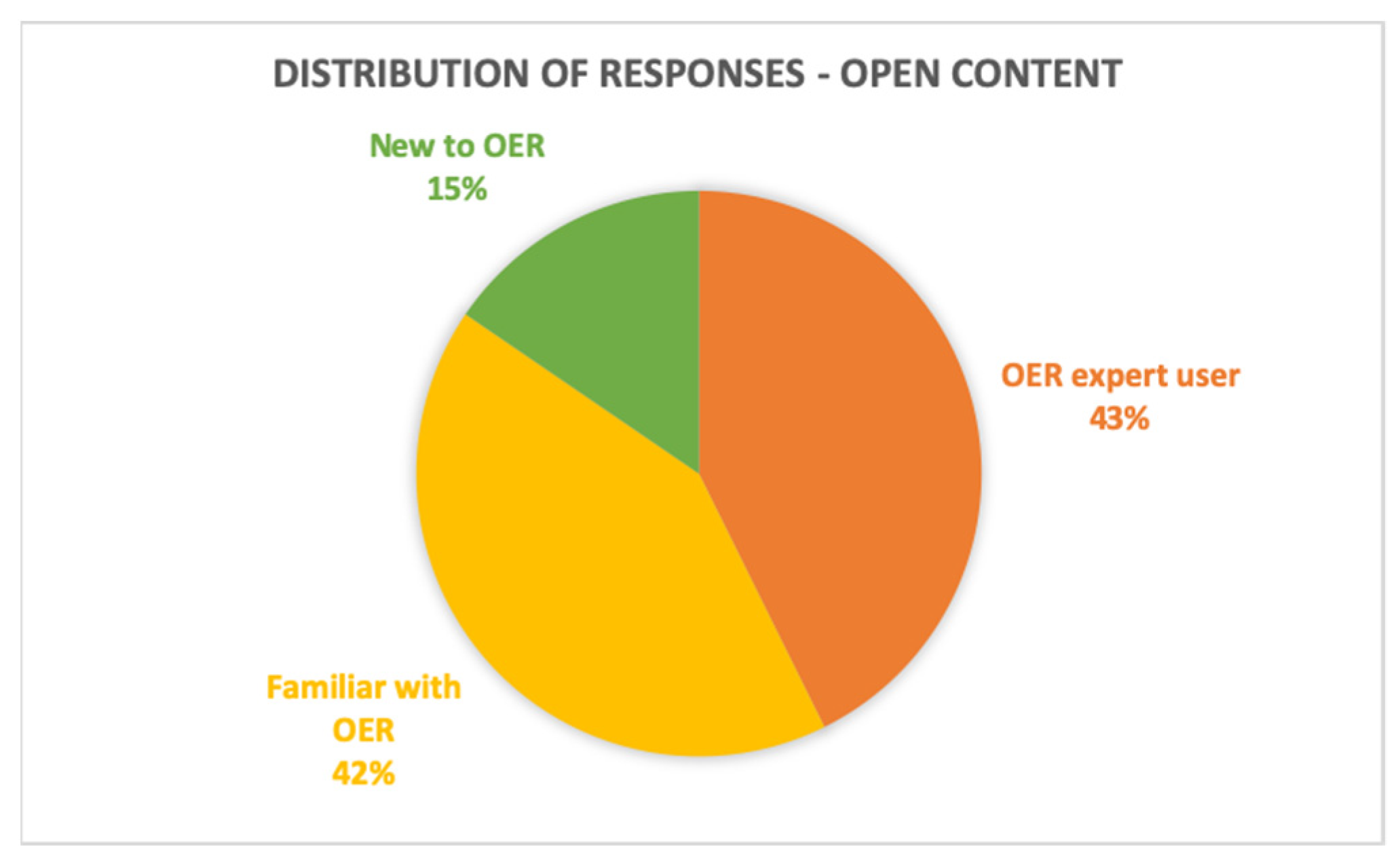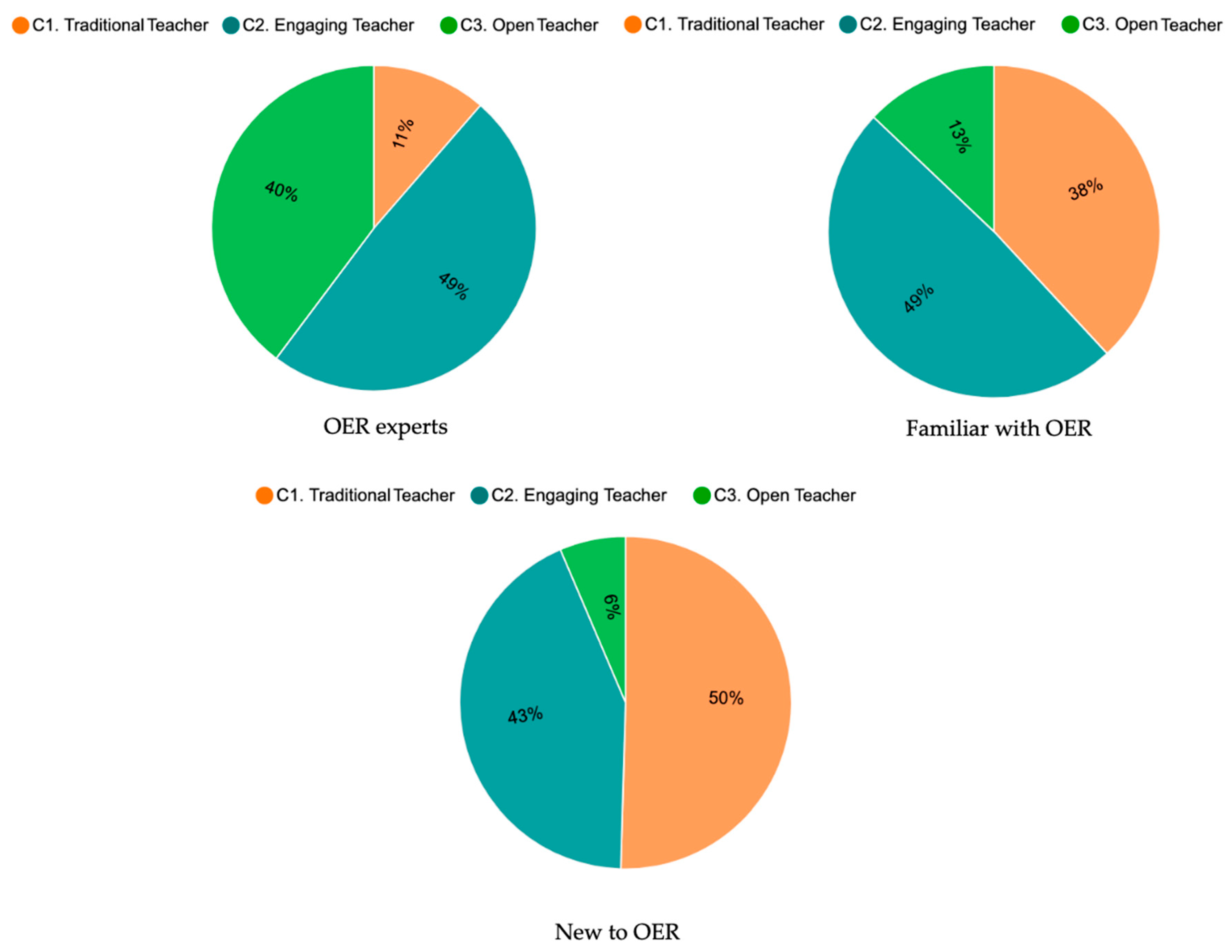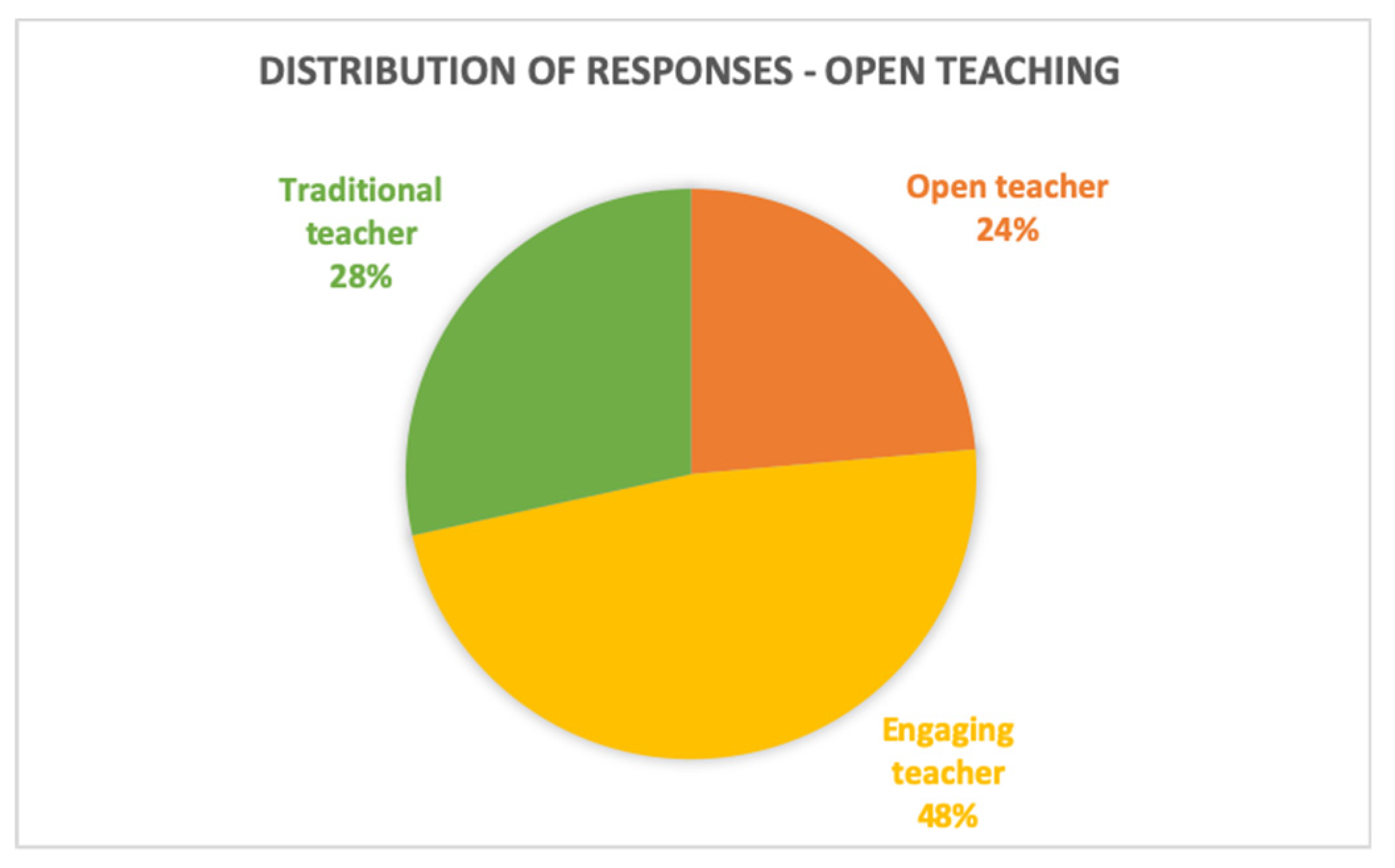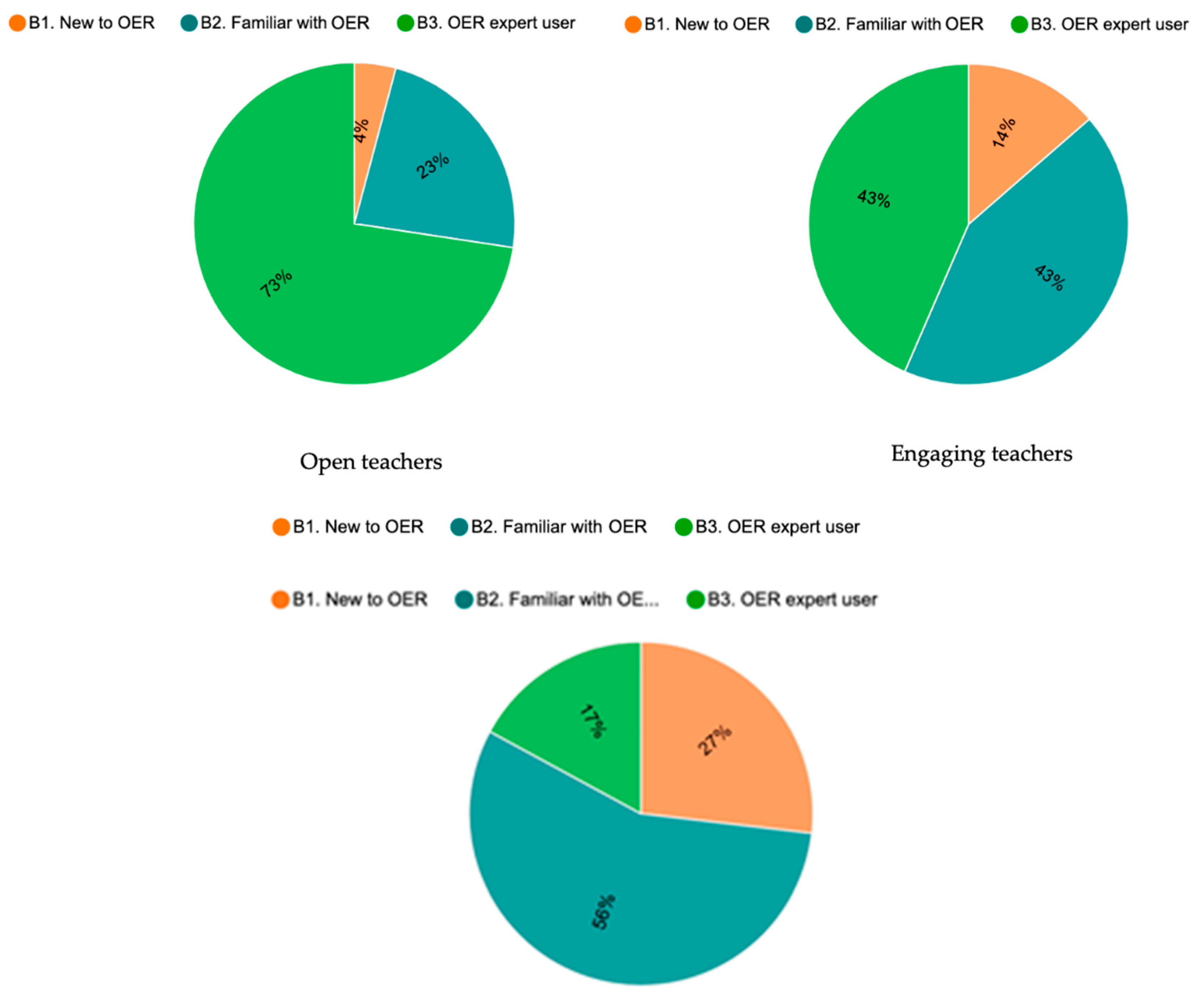Unveiling the Relationship between the Use of Open Educational Resources and the Adoption of Open Teaching Practices in Higher Education
Abstract
1. Introduction
2. Methodology
3. Results
3.1. Use of Open Teaching Methods among Different Categories of OER Users
3.2. Use of OER among Different Categories of Open Teachers
4. Discussion
5. Conclusions
Author Contributions
Funding
Conflicts of Interest
Appendix A. Multiple-Choice Questionnaire
- (1)
- How do you design your lectures/courses?
- a)
- On my own, based on my experience and knowledge, as I have always done. (result: individual designer)
- b)
- In collaboration with colleagues from my institution. (result: collaborative designer)
- c)
- In collaboration with colleagues from other institutions, through bilateral contacts. (result: collaborative designer)
- d)
- I share ideas and drafts about my course through restricted social media (such as subject-related discussion groups) to allow colleagues from other institutions to contribute. (result: open designer)
- e)
- I share ideas and drafts about my course through open social media (such as twitter, academia.edu, cloudworks), to allow anyone (including students) to contribute. (result: open designer)
- (2)
- To whom do you make available your teaching resources (PPTs, documents)?
- a)
- To students enrolled in my course, through the university website. (result: New to OER)
- b)
- To all students of my university, through the university website. (result: Familiar with OER)
- c)
- I make it openly available to anyone, through the university website. (result: Familiar with OER)
- d)
- I make it openly available to anyone, through sharing platforms (Slideshare, repositories, etc). (result: OER Expert)
- e)
- I also promote the content I produce through social media (such as Twitter, Slideshare, Facebook, Wikipedia…). (result: OER Expert)
- (3)
- Under which licence do you release the teaching resources you produce?
- a)
- I do not apply any licence, I just make it available to through the university website. (New to OER)
- b)
- Through a restricted licence (all rights reserved). (result: New to OER)
- c)
- Through a licence that makes it openly available (such as Creative Commons). (result: OER Expert)
- (4)
- Have you ever been using online resources (PPTs, videos, documents, articles) produced by others in your teaching? If so, under which license was this content released?
- a)
- No, do not use online content produced by others in my teaching. (result: New to OER)
- b)
- Yes. I am not worried about the license of these resources, since I used it for educational purposes. (result: Familiar with OER)
- c)
- Yes. I only use resources released under an open licence, such as Creative Commons. (result: OER Expert)
- (5)
- How did you get to know about these resources?
- a)
- I have been searching for them on Google or other search engines. (result: New to OER)
- b)
- Through a colleague from my university. (result: New to OER)
- c)
- Through social media (such as Twitter, Slideshare, Facebook). (result OER Expert)
- d)
- Through OER repositories. (result: Familiar with OER or OER Expert)
- (6)
- Have you ever re-shared resources produced by others after using/adapting them?
- a)
- No, never. (result: New to OER)
- b)
- Yes, among colleagues from my university. (result: New to OER or Familiar with OER)
- c)
- Yes, openly through social media (such as Twitter, Slideshare, Facebook). (result: Familiar with OER or OER Expert)
- d)
- Yes, openly through OER repositories. (result: Familiar with OER or OER Expert)
- (7)
- How do you teach?
- a)
- I use classic, frontal classroom teaching. (result: Traditional Teacher)
- b)
- I use the university Learning Management System (LMS) in support to classroom teaching, to share links and documents. (result: Traditional Teacher or Engaging Teacher)
- c)
- I use seminars-like strategies, either offline or through restricted online spaces (Chats, forums). (result: Engaging Teacher)
- d)
- I use “flipped-classroom” methodologies (using classroom time to discuss content that students have studies at home before the lesson). (result: Engaging Teacher)
- e)
- I encourage my students to search for additional resources on the web and to produce their own knowledge. (result: Open Teacher)
- f)
- I try to foster co-creation of knowledge by students by working with wikis, blogs, communities of practices. (result: Open Teacher)
- (8)
- Do you encourage participation from non-enrolled students in your courser?
- a)
- Yes (result: Open Teacher)
- b)
- No (result: Traditional Teacher or Engaging Teacher)
- (9)
- How do you assess your students?
- a)
- I assess them through tests and classwork. (result: Traditional Evaluator)
- b)
- I am introducing peers-assessment, either offline or through online means. (result: Innovative Evaluator)
- c)
- My students have digital portfolios and are assessed through that. (result: Innovative Evaluator)
- d)
- My students are assessed by online communities of Practices. (result: Open Evaluator)
References
- Bayne, S.; Knox, J.; Ross, J. Open education: The need for a critical approach. Learn. Media Technol. 2015, 40, 247–250. [Google Scholar] [CrossRef]
- Schaffert, S.; Geser, G. Open Educational Resources and Practices. In Elearning Papers. Promoting Innovation in Lifelong Learning. Special Edition 2008; Carneiro, R., Tarin, L., Eds.; PAU Education: Barcelona, Spain, 2008; pp. 14–19. [Google Scholar]
- Cronin, C. Openness and praxis: Exploring the use of open educational practices in higher education. Int. Rev. Res. Open Distrib. Learn. 2017, 18. [Google Scholar] [CrossRef]
- Havemann, L. Open in the evening: Openings and closures in an ecology of practices. In Ecologies of Open; Conrad, D., Prinsloo, P., Eds.; Athabasca University Press: Athabasca, AB, Canada, forthcoming.
- DeRosa, R.; Robison, S. From OER to Open Pedagogy: Harnessing the Power of Open. In Open: The Philosophy and Practices that are Revolutionizing Education and Science; Jhangiani, R.S., Biswas-Diener, R., Eds.; Ubiquity Press: London, UK, 2017; pp. 115–124. [Google Scholar] [CrossRef]
- Wiley, D.; Hilton, J. Defining OER-Enabled Pedagogy. Int. Rev. Res. Open Distrib. Learn. 2018, 19. [Google Scholar] [CrossRef]
- Veletsianos, G.A. case study of scholars’ open and sharing practices. Open Prax. 2015, 7, 199–209. [Google Scholar] [CrossRef]
- Jhangiani, R.S. Open as Default: The Future of Education and Scholarship. In Open: The Philosophy and Practices that are Revolutionizing Education and Science; Jhangiani, R.S., Biswas-Diener, R., Eds.; Ubiquity Press: London, UK, 2017; pp. 267–279. [Google Scholar] [CrossRef]
- UNESCO. Recommendation on Open Educational Resources; UNESCO: Paris, France, forthcoming.
- Stacey, P. The Pedagogy of MOOCs. Edtechfrontier.com. Available online: http://edtechfrontier.com/2013/05/11/the-pedagogy-of-moocs/ (accessed on 8 July 2019).
- Reynolds, R. Eight Qualities of Open Pedagogies. Available online: https://nextthought.com/thoughts/2015/02/ten-qualities-of-open-pedagogy (accessed on 8 July 2019).
- Hegarty, B. Attributes of Open Pedagogy: A Model for Using Open Educational Resources. Educ. Technol. 2015, 55, 3–13. [Google Scholar]
- Nascimbeni, F.; Burgos, D. In search for the Open Educator: Proposal of a definition and a framework to increase openness adoption among university educators. Int. Rev. Res. Open Distrib. Learn. 2016, 17. [Google Scholar] [CrossRef]
- de Wit, H. Globalisation and internationalisation of Higher Education. Int. J. Educ. Technol. High. Educ. 2011, 8, 241–248. [Google Scholar] [CrossRef]
- Wiley, D. Defining the "Open" in Open Content and Open Educational Resources. Available online: https://opencontent.org/definition/ (accessed on 11 October 2019).
- Ferguson, R.; Barzilai, S.; Ben-Zvi, D.; Chinn, C.A.; Herodotou, C.; Hod, Y.; Kali, Y.; Kukulska-Hulme, A.; Kupermintz, H.; McAndrew, P.; et al. Innovating Pedagogy 2017: Open University Innovation Report 6; The Open University: Milton Keynes, UK, 2017. [Google Scholar]
- Pete, J.; Mulder, F.; Dutra Oliveira Neto, J. Differentiation in Access to, and the Use and Sharing of (Open) Educational Resources among Students and lecturers at Kenyan Universities. Open Praxis 2017, 9, 173–194. [Google Scholar] [CrossRef]
- Hilton, J.; Fischer, L.; Wiley, D.; Williams, L. Maintaining Momentum toward Graduation: OER and the Course Throughput Rate. Int. Rev. Res. Open Distrib. Learn. 2016, 17. [Google Scholar] [CrossRef][Green Version]
- Downes, S. Learning Networks in Practice. In Emerging Technologies for Learning; Ley, D., Ed.; BECTA: Coventry, UK, 2007. [Google Scholar]
- Tuomi, I. Open Educational Resources and the Transformation of Education. Eur. J. Educ. 2013, 48, 58–78. [Google Scholar] [CrossRef]
- Nascimbeni, F.; Burgos, D.; Campbell, L.M.; Tabacco, A. Institutional mapping of open educational practices beyond use of Open Educational Resources. Distance Educ. 2018, 39, 511–527. [Google Scholar] [CrossRef]
- Bossu, C.; Willems, J. OER based capacity building to overcome staff equity and access issues in higher education. In Proceedings of the ASCILITE2017: 34th International Conference on Innovation, Practice and Research in the Use of Educational Technologies in Tertiary Education, Toowoomba, Australia, 4–6 December 2017; pp. 22–26. [Google Scholar]
- Stracke, C.M. Quality Frameworks and Learning Design for Open Education. Int. Rev. Res. Open Distrib. Learn. 2019, 20, 180–203. [Google Scholar] [CrossRef]
- Weller, M.; Jordan, K.; DeVries, I.; Rolfe, V. Mapping the Open Education Landscape: Citation Network Analysis of Historical Open and Distance Education Research. Open Praxis 2018, 10, 109–126. [Google Scholar] [CrossRef]
- Dos Santos, A.I. Practical Guidelines on Open Education for Academics: Modernising Higher Education via Open Educational Practices; (Based on the OpenEdu Framework), EUR 29672 EN; Publications Office of the European Union: Brussels, Belgium, 2019. [Google Scholar] [CrossRef]




| Design | Content | Teaching | Assessment |
|---|---|---|---|
| Open designer | Expert OER user | Open teacher | Open evaluator |
| Collaborative designer | Familiar with OER | Engaging teacher | Innovative evaluator |
| Individual designer | New to OER | Traditional teacher | Traditional evaluator |
© 2019 by the authors. Licensee MDPI, Basel, Switzerland. This article is an open access article distributed under the terms and conditions of the Creative Commons Attribution (CC BY) license (http://creativecommons.org/licenses/by/4.0/).
Share and Cite
Nascimbeni, F.; Burgos, D. Unveiling the Relationship between the Use of Open Educational Resources and the Adoption of Open Teaching Practices in Higher Education. Sustainability 2019, 11, 5637. https://doi.org/10.3390/su11205637
Nascimbeni F, Burgos D. Unveiling the Relationship between the Use of Open Educational Resources and the Adoption of Open Teaching Practices in Higher Education. Sustainability. 2019; 11(20):5637. https://doi.org/10.3390/su11205637
Chicago/Turabian StyleNascimbeni, Fabio, and Daniel Burgos. 2019. "Unveiling the Relationship between the Use of Open Educational Resources and the Adoption of Open Teaching Practices in Higher Education" Sustainability 11, no. 20: 5637. https://doi.org/10.3390/su11205637
APA StyleNascimbeni, F., & Burgos, D. (2019). Unveiling the Relationship between the Use of Open Educational Resources and the Adoption of Open Teaching Practices in Higher Education. Sustainability, 11(20), 5637. https://doi.org/10.3390/su11205637






